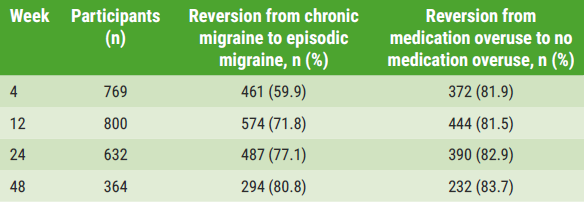Dr Tessa de Vries (Erasmus Medical Center, the Netherlands) explained that gepants and erenumab theoretically target the same receptor, CLR/RAMP1, so that no additional effects of a gepant on top of erenumab would be expected [1]. De Vries and colleagues put this to the test by studying the effect of erenumab in combination with rimegepant, olcegepant, or sumatriptan on CGRP-induced vasorelaxation in isolated human HCA. They used HCA segments from donors (11 women and 6 men; mean age 53 years).
The relaxation caused by CGRP in segments incubated with 3 µM erenumab was reversed by sumatriptan (134%), rimegepant (91%), and olcegepant (92%). The vasoconstrictive effects of sumatriptan were as expected, since it targets a different receptor: 5-HT18/1D(/1F). Unexpectedly, both rimegepant and olcegepant exerted additional CGRP-inhibiting effects on top of the maximum effect of erenumab. Olcegepant did not induce additional effects on top of erenumab for the agonists adrenomedullin and pramlintide. A possible explanation is that different receptor populations may mediate the effects of adrenomedullin, pramlintide, and CGRP.
Dr De Vries suggested 2 possible reasons why the 2 gepants exerted additional effects on top of erenumab. The first is that the mechanism of action of erenumab and gepants are not identical. “Maybe they target different receptors; for example, gepants may also target AMY1 or other receptors of the CGRP-receptor family that are not, or to a lesser extent, affected by erenumab.” It is known that rimegepant and olcegepant antagonism at the AMY1 receptor is 17-30 and about 150 times lower, respectively, compared with the CGRP receptor. The second explanation is that receptor internalisation is involved. “The CGRP receptor can still signal after internalisation, which plays a role in pain transmission. Maybe gepants can target the receptor even after internalisation, whereas the very large erenumab molecule cannot.”
The clinical relevance of these findings, said Dr De Vries, is that a patient taking erenumab as a prophylactic migraine treatment could benefit from taking a gepant as acute treatment, as gepants can induce additional receptor blockade on top of erenumab, regardless of the erenumab dosage. This might, however, result in additional safety concerns.
- De Vries T. Differential mechanism of action of erenumab and gepants in human isolated coronary arteries. A11, EHC 2022, 07–10 December, Vienna, Austria.
Copyright ©2022 Medicom Medical Publishers
Posted on
Previous Article
« ASH 2022 Highlights Podcast Next Article
Persistent headache after stroke: not rare and often overlooked »
« ASH 2022 Highlights Podcast Next Article
Persistent headache after stroke: not rare and often overlooked »
Table of Contents: EHC 2022
Featured articles
EHF consensus on effective migraine treatment and triptan failure
IHS President: “It is time for operationalisation of ICHD”
Headache Prophylaxis
Intervention
EHF consensus on effective migraine treatment and triptan failure
Sustained long-term effect of occipital nerve stimulation in MICCH
Onabotulinumtoxin A effective in older patients with chronic migraine
What to do when conventional treatment of headache fails in children
Predicting response to medical and surgical treatment of trigeminal neuralgia
Breakthroughs in Understanding Headache
IHS President: “It is time for operationalisation of ICHD”
GWAS identifies 7 loci for cluster headache
Towards precision medicine: salivary CGRP and erenumab response
Persistent headache after stroke: not rare and often overlooked
Additional effects of gepants on top of erenumab
Headache Prevention
Idiopathic intracranial hypertension: key factors influencing visual outcomes
Patients with migraines smoke less, drink less, and use fewer illicit drugs than general population
Related Articles

August 27, 2019
Fremanezumab results of the FOCUS study

© 2024 Medicom Medical Publishers. All rights reserved. Terms and Conditions | Privacy Policy
HEAD OFFICE
Laarderhoogtweg 25
1101 EB Amsterdam
The Netherlands
T: +31 85 4012 560
E: publishers@medicom-publishers.com

